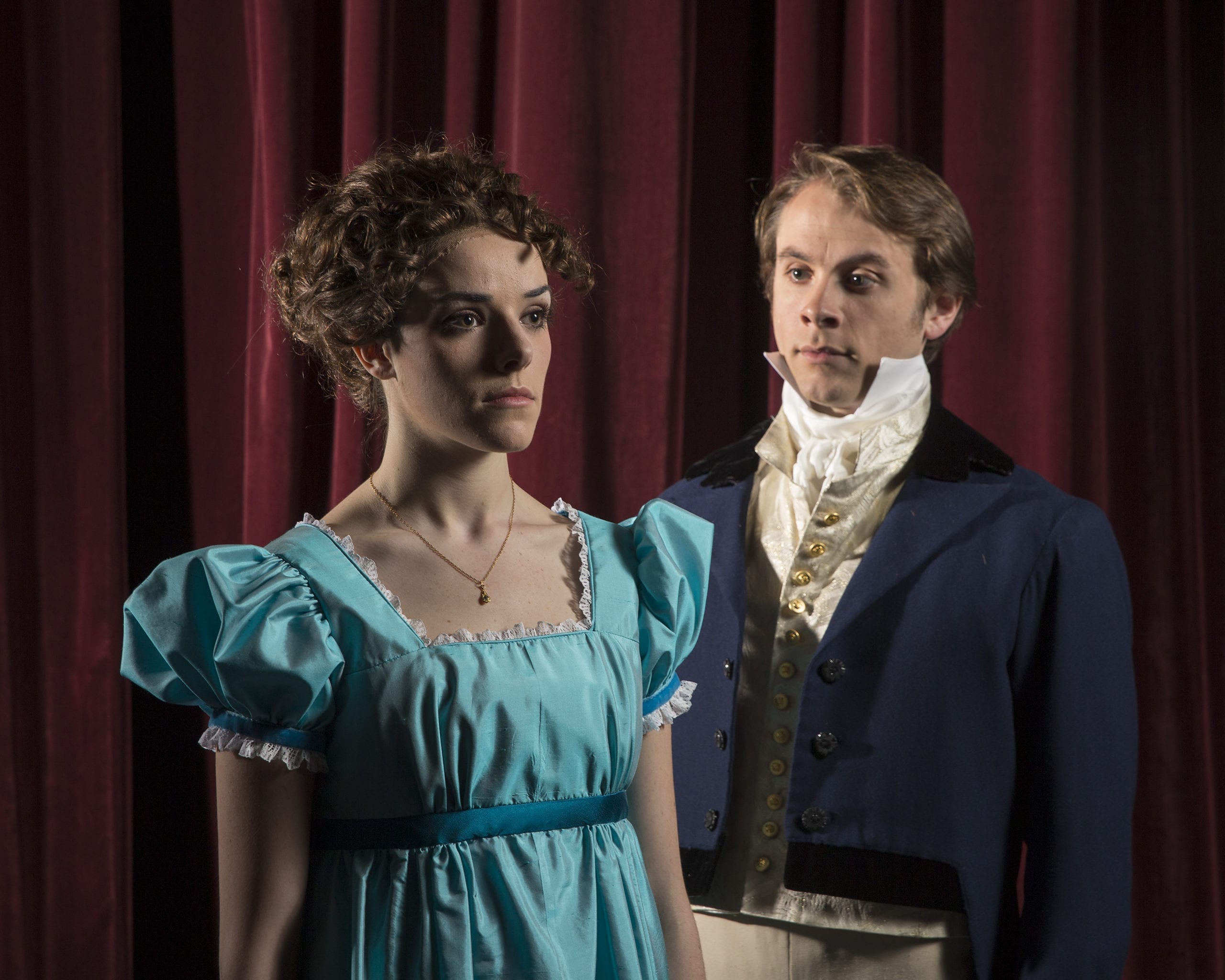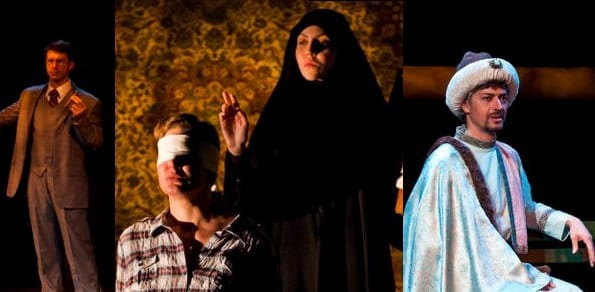PROVO — There is something special about Pride and Prejudice. It seems to have a timeless resonance in our society and our personal lives. My sisters forced me to watch the five-hour A&E version when I was a doubting teenager. This proved advantageous, as my friends would write letters in code referring to others as their “Darcy,” “Bingley,” or “Colonel Fitzwilliam.” I’m sure they weren’t the only ones to ever do this over the last 200 years. Melissa Leilani Larson’s new world premiere Jane Austen’s Pride and Prejudice at BYU has been faithful to the beloved novel, creatng a charming evening that delivers on favorite moments while helping enlighten some less familiar ones as well.
Adapting any beloved text has its dangers due to high audience expectations. When I read Jane Austen’s classic text, the vibrant dialogue made her unique characters so real. Larson’s new script compares well to Austen’s text. The script is a worthy addition to the canon of adaptations and should be sought after by theatre companies that wish to bring to life Jane Austen’s. Larson’s tight script flows well from one scene to another and deals well with the classic characteristics from the story. While much of the dialogue can be taken directly from Austen’s source work, it has been placed together to create intimate piece of theatre full of the wit and precision of the original. Some unique scenes included a poignant moment for Ms. Bingley when her brother asks, “How do you know that feeling is more than a feeling?” Her heartfelt response was a reply that resonates with anyone who has had a broken heart as she looked down from upper levels at lost love. Likewise, Mary’s interest in Collins added a delightfully comedic, yet endearing subplot when she is left wanting for his affections.
Karli Hall as Elizabeth Bennet carried the majority of the script as she navigated her personal and familial efforts to find love and marriage. Hall brings all the curt and insightful commentary of Elizabeth with splendid ease. While her sarcasm, wit, and intensity all were brought out in every scrape with Darcy and confession with Jane, I still had a strange feeling early in act 2 that I missed her smile. But as Elizabeth finally shows her love for Darcy, her smile radiates from her amazement of finding a truly selfless man. I truly appreciated Hall’s performance in that moment. However, I because Elizabeth seemed lacking in genuine enjoyment from wit or sisterly confidences, I found the character a little flat.
On the other hand, Ted Bushman’s Darcy held all the confident reserve in perfect stature. It was a pleasure to see him open up a little at a time to friends and eventually to Lizzie. There was also a special depth in Bushamn’s performance that helped me understand Darcy more than I ever have. Bushman’s reactions showed his sincere concern and immediate resolve for his dearest family and friends. This was accented by moments in Larson’s script, like Lizzie describing the “gentle influence of Darcy’s father, his careful consideration for his sister in every room” at Pemberley and Darcy’s immediate resolve leading to the tense but humorous little scene to correct Lydia and Wickham’s folly by arranging their marriage.
The remaining characters often felt like they were leaping off the page to the stage. Standout performances to Jacob Swain as Collins hilariously followed people, startling them. His performance was faithful to the observation that “people of the cloth are often known for their stealth.” Austin Jensen as Bingley was a pleasure to see in all his awkwardness as he fell in love with Jane over and over again. Perhaps the only character that I felt was a little over the top was Mrs. Bennet, played by Laura Wardle. Her exasperations over her daughters’ marital prospects were comical, but lacked grounding in reality for me. However, I have never fully understood this character and her “nerves.”
I appreciated the uniquely theatrical aspects of the production. This was not an effort to recreate one of the many film version into a stage production. Larson and director Barta Heiner helped incorporate important parts like letter writing and family portraits to splendid dramatic effect. The scenes of letter writing had the possibility to feel inconsistent, yet never did. For example, Ms. Bingley’s typically sardonic fair had her standing off in the corner speaking through her letter.At another time, Darcy actively verbalized while writing to his sister, creating the comedic effect of him writing guardedly about Elizabeth while she is in the same room. This allowed each letter to become intensely personal—something we lack so often in our Tweet-filled world. While movies have obviously visualized the story, under Heiner’s direction Darcy explains events directly to Elizabeth while also acting in many of the fateful moments. Heiner also established the rules of decency and interactions of the era through the blocking. However, the depth of each characters story was best exhibited during the Regency dances. A preeminent example is Collins’s clumsiness in his first dance and his endless attention to Elizabeth while Darcy danced. The other actors were always filling their part as giggling teenagers or concerned friends even as the dance swirled about them. Heiner made the characters human instead of historic caricatures.
The use of portraits unified the production from beginning to end. The first glimpse as the lights come up is the Bennett family sitting as if for a portrait. Subsequently, an individual or familial portrait introduced each character as they stood in the intended pose and were framed by a portrait frame of light. The strong visual impression, enhanced by a little dialogue, introduced a multitude of characteristics in only a few seconds. Likewise, as each marriage occurred throughout the story, there was a new couple portrait, which brilliantly displayed the type of marriage that was being formed, from comical to poignant.
The set designed by Rory Scanlon worked well for the quick pace of the show. A gold-colored stage and curtains had a retractable platform on each side of the stage that could be rotated on individually or together to demonstrate the size of the house presented. Open space was used when outdoors and some stairs to much higher platforms at the rear showed the upper levels and allowed also for ideal places to create the portraits in the background while the scene took place downstage. The lighting (designed by Michael Kraczek) reflected salons, ballrooms, and gentle outdoor lighting along with appropriate furniture choices (Sara Myers) to accentuate the feel of the location. There was a glitch or two with timing of the lighting and dropping a curtain for a portrait and an occasionally noisy scene change, but otherwise the story moved flawlessly around various places in England.
I believe anyone who loves Austen and her beloved book will adore this new play version. So grab a girlfriend (or boyfriend who needs to appreciate some funny and finer things in life) and fall in love again with Pride and Prejudice.






